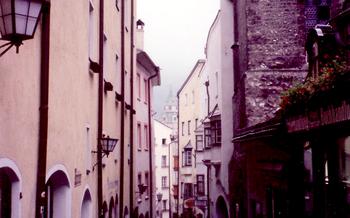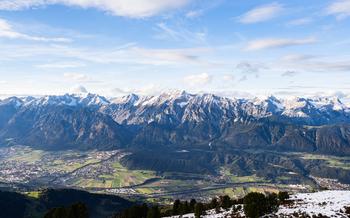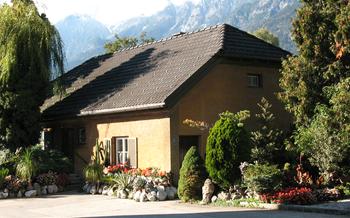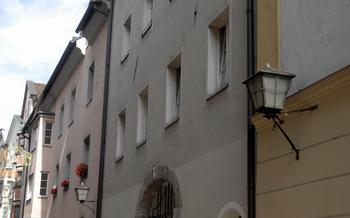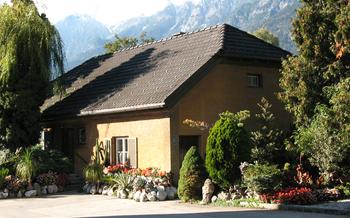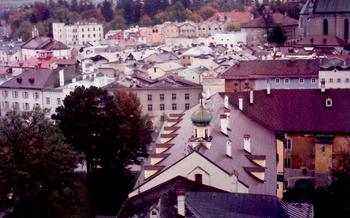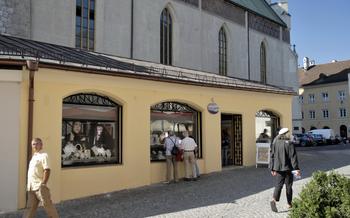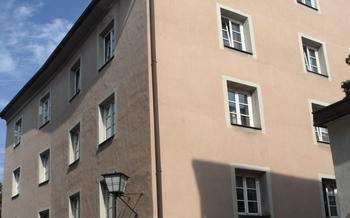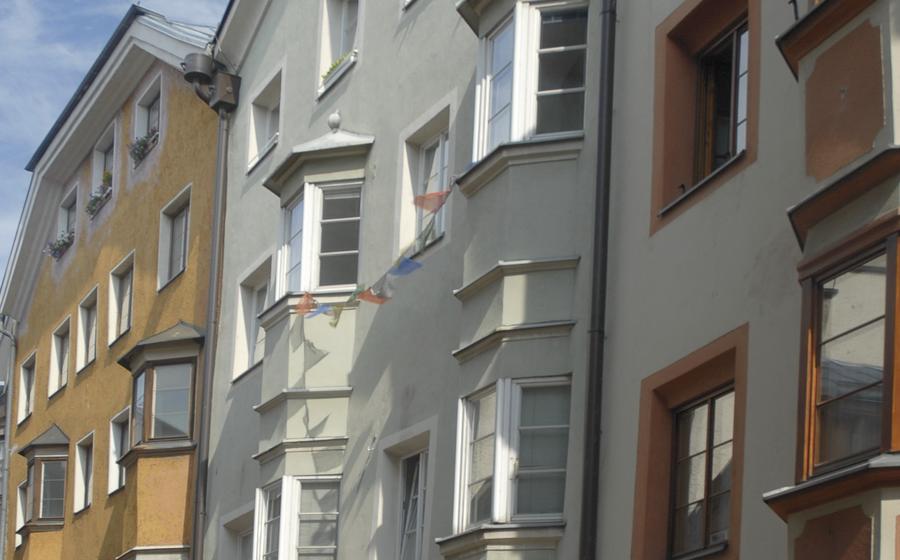
Hall Mining Museum
- Hall in Tirol: A Historic Town in the Austrian Alps
- Hall Mining Museum: A Journey Through Mining History
- The Mining Shaft: A Descent into the Depths
- Minerals and Geology
- Mining Techniques
- The Miner's Life
- The Role of Mining in Hall's History
- Mining and the Environment
- Guided Tours and Workshops
- Museum Shop and Café
- Accessibility and Facilities
- Getting to the Museum
- Insider Tip: Unveiling Hall's Mining Heritage at its Finest
Hall in Tirol: A Historic Town in the Austrian Alps
Nestled amidst the breathtaking Austrian Alps, Hall in Tirol is a charming town with a rich history and a unique identity shaped by its mining heritage. In the Middle Ages, Hall was renowned as a significant mining center, extracting valuable minerals such as silver and copper from the surrounding mountains. The town's mining wealth fueled its development, leaving behind a legacy of well-preserved medieval architecture that transports visitors back in time.
Strolling through the narrow cobblestone streets of Hall, one can admire the intricate facades of historic buildings, many of which date back to the 15th and 16th centuries. The town square, Marktplatz, is dominated by the impressive town hall, a masterpiece of Gothic architecture, and the iconic Mint Tower, a symbol of Hall's prosperous past.
Hall Mining Museum: A Journey Through Mining History
Nestled within the heart of the historic town center of Hall in Tirol, the Hall Mining Museum invites visitors on a captivating journey through the town's rich mining heritage. Established in 1977, the museum occupies a historic building that once housed the town's mining administration offices. Its exhibits bring to life the story of Hall's mining past, showcasing the tools, techniques, and traditions that shaped the town's identity for centuries.
The museum's collection boasts an array of artifacts, documents, and interactive displays that provide a comprehensive overview of Hall's mining history. Visitors can trace the evolution of mining techniques from the early days of hand-operated tools to the introduction of more advanced machinery. Detailed explanations and audio-visual presentations enhance the experience, offering insights into the challenges and dangers faced by miners throughout the ages.
The Mining Shaft: A Descent into the Depths
At the heart of the Hall Mining Museum lies its most captivating attraction—a meticulously recreated medieval mining shaft. This immersive exhibit transports visitors back in time, allowing them to experience firsthand the arduous conditions faced by miners centuries ago.
Descending into the replica shaft is a thrilling journey into the depths of the earth. The dimly lit tunnel, complete with creaking timbers and dripping water, evokes the atmosphere of a genuine mine. Visitors can don protective gear and wield replica mining tools as they explore the narrow passageways and learn about the techniques used to extract valuable ores.
Interactive displays and audio-visual presentations further enhance the experience, providing insights into the challenges and dangers encountered by miners. Visitors can listen to the sounds of hammers striking rock, the creaking of mining carts, and the chatter of miners communicating through the darkness.
Minerals and Geology
The Hall Mining Museum also houses a remarkable collection of minerals and geological specimens. Visitors can explore the diverse minerals found in the Hall region, including various ores, gemstones, and crystals. Interactive displays provide insights into the formation of these minerals and the geological processes that shaped the region's landscape. Hands-on activities, such as mineral identification quizzes and touchscreens with interactive geological maps, engage visitors of all ages, allowing them to delve deeper into the fascinating world of mineralogy.
Mining Techniques
The Hall Mining Museum offers visitors the chance to delve into the intricate world of mining techniques employed in the past. Detailed explanations and demonstrations showcase the methods used by miners to extract and process valuable ores. Traditional techniques such as ore extraction and processing are brought to life, providing insights into the challenges and dangers faced by miners in their quest for precious resources. Interactive displays allow visitors to experience the complexities of mining firsthand, while historical artifacts and documents illustrate the evolution of mining techniques over time.
The Miner's Life
The Hall Mining Museum offers a glimpse into the daily lives of the miners and their families who played a crucial role in the town's history. Through captivating exhibitions, visitors can explore the challenges, struggles, and triumphs that shaped the miners' existence.
Displays of miners' clothing, tools, and personal belongings provide a tangible connection to their everyday lives. These artifacts tell stories of hard work, camaraderie, and the sacrifices made to extract valuable minerals from the depths of the earth.
Interactive exhibits invite visitors to step into the shoes of a miner, experiencing the harsh conditions they faced. From the cramped and poorly ventilated shafts to the backbreaking labor of ore extraction, these displays offer a profound appreciation for the resilience and determination of these individuals.
The museum also sheds light on the social and cultural aspects of the miners' lives. From the strong bonds formed among colleagues to the traditions and rituals that marked their community, visitors gain insights into the unique culture that developed within the mining community.
Through personal stories and anecdotes, the museum humanizes the experiences of the miners, allowing visitors to connect with their struggles and triumphs on a personal level. These narratives bring to life the sacrifices made by generations of miners who shaped the history and prosperity of Hall in Tirol.
The Role of Mining in Hall's History
Mining has played a pivotal role in shaping the history and identity of Hall in Tirol. The town's prosperity and development were inextricably linked to the extraction and trade of valuable minerals, particularly silver and copper. Historical documents and artifacts showcased in the museum provide a glimpse into the town's mining past.
Interactive maps and timelines trace the evolution of the mining industry, from its humble beginnings to its peak in the 16th century. Visitors can learn about the challenges faced by miners, the technological innovations that transformed mining practices, and the economic and social impact of mining on the community.
Exhibits highlight the contributions of mining to Hall's cultural heritage, including the construction of magnificent buildings, the establishment of guilds and associations, and the development of a distinct mining culture. The museum offers a comprehensive understanding of how mining shaped the identity of Hall in Tirol and left an enduring legacy that continues to influence the town today.
Mining and the Environment
The Hall Mining Museum also delves into the environmental impact of mining activities. Thought-provoking displays highlight the historical consequences of mining on the surrounding landscape, raising awareness of the ecological challenges faced by mining communities. Visitors can learn about sustainable mining practices and the efforts undertaken to minimize environmental damage. Interactive exhibits promote responsible resource management, encouraging visitors to consider the long-term implications of mining on the planet. This section of the museum serves as a reminder of the delicate balance between resource extraction and environmental preservation, encouraging visitors to reflect on the importance of responsible stewardship of our natural resources.
Guided Tours and Workshops
To enhance your experience at the Hall Mining Museum, guided tours are available in multiple languages, providing a deeper understanding of the exhibits and the history of mining in Hall. These tours led by knowledgeable guides bring the museum to life, offering insights and anecdotes that enrich your visit.
Additionally, the museum offers hands-on workshops and educational programs, catering to families and school groups. These interactive sessions allow visitors to engage with the mining heritage of Hall in a practical way. Activities may include panning for gold, creating replicas of mining tools, or learning about mineralogy through hands-on experiments.
Advance booking is recommended to secure a spot on a guided tour or workshop, ensuring a personalized and memorable experience for all visitors.
Museum Shop and Café
The Hall Mining Museum offers a well-stocked gift shop where visitors can purchase souvenirs, mining-related items, and educational materials. From postcards and magnets featuring historic mining scenes to replicas of mining tools and minerals, there's something for everyone interested in preserving the memory of their visit. The shop's proceeds contribute directly to the sustainability of the museum, ensuring its continued operation and preservation of Hall's rich mining heritage.
Adjacent to the gift shop is a cozy café providing refreshments and snacks for visitors. Here, you can relax and refuel after exploring the museum's exhibits. Enjoy a cup of coffee or tea paired with a traditional Austrian pastry while immersing yourself in the captivating stories of Hall's mining past. The café's revenue also supports the museum, allowing it to continue its important work of preserving and showcasing the town's mining legacy.
Accessibility and Facilities
The Hall Mining Museum is committed to providing an inclusive and accessible experience for all visitors. The museum is wheelchair accessible, with ramps and elevators ensuring that all exhibits are easily reached. Accessible restrooms, baby changing facilities, and lockers are also available for convenience.
To enhance the visitor experience, the museum offers multilingual signage and audio guides in various languages, ensuring that international visitors can fully engage with the exhibits and learn about the fascinating history of mining in Hall in Tirol.
Getting to the Museum
Reaching the Hall Mining Museum is a breeze, whether you choose to drive, hop on public transport, or embark on a leisurely stroll. For those arriving by car, simply follow the signs leading to the town center and look for the "Museum Hall in Tirol" signs. Ample parking options are available nearby, catering to both regular-sized vehicles and tour buses.
If you prefer to leave the driving to someone else, public transportation is an excellent option. Regular bus services connect the museum to various parts of the town and the surrounding region. Just check the schedules and hop on the bus that takes you closest to the museum.
For those who enjoy stretching their legs and immersing themselves in the town's ambiance, a leisurely walk to the museum is highly recommended. Starting from the historic town center, follow the picturesque streets and charming alleys, taking in the sights and sounds of Hall in Tirol. The museum is just a short stroll away, and you'll have the chance to admire the town's well-preserved medieval architecture along the way.
Insider Tip: Unveiling Hall's Mining Heritage at its Finest
For an unparalleled immersion into Hall's mining legacy, plan your visit to coincide with the annual "Hall in Tirol Mining Festival." This vibrant celebration, held during the summer months, transforms the town into a living museum, showcasing traditional mining techniques, historical reenactments, and captivating performances. Experience the infectious energy as locals and visitors alike don period costumes, filling the streets with laughter, music, and a palpable sense of camaraderie. Don't miss the chance to witness live demonstrations of ore extraction, panning for gold, and other fascinating mining activities that bring the town's history to life. Immerse yourself in the infectious atmosphere, savor the local delicacies, and capture the essence of Hall's rich mining heritage through your lens.
